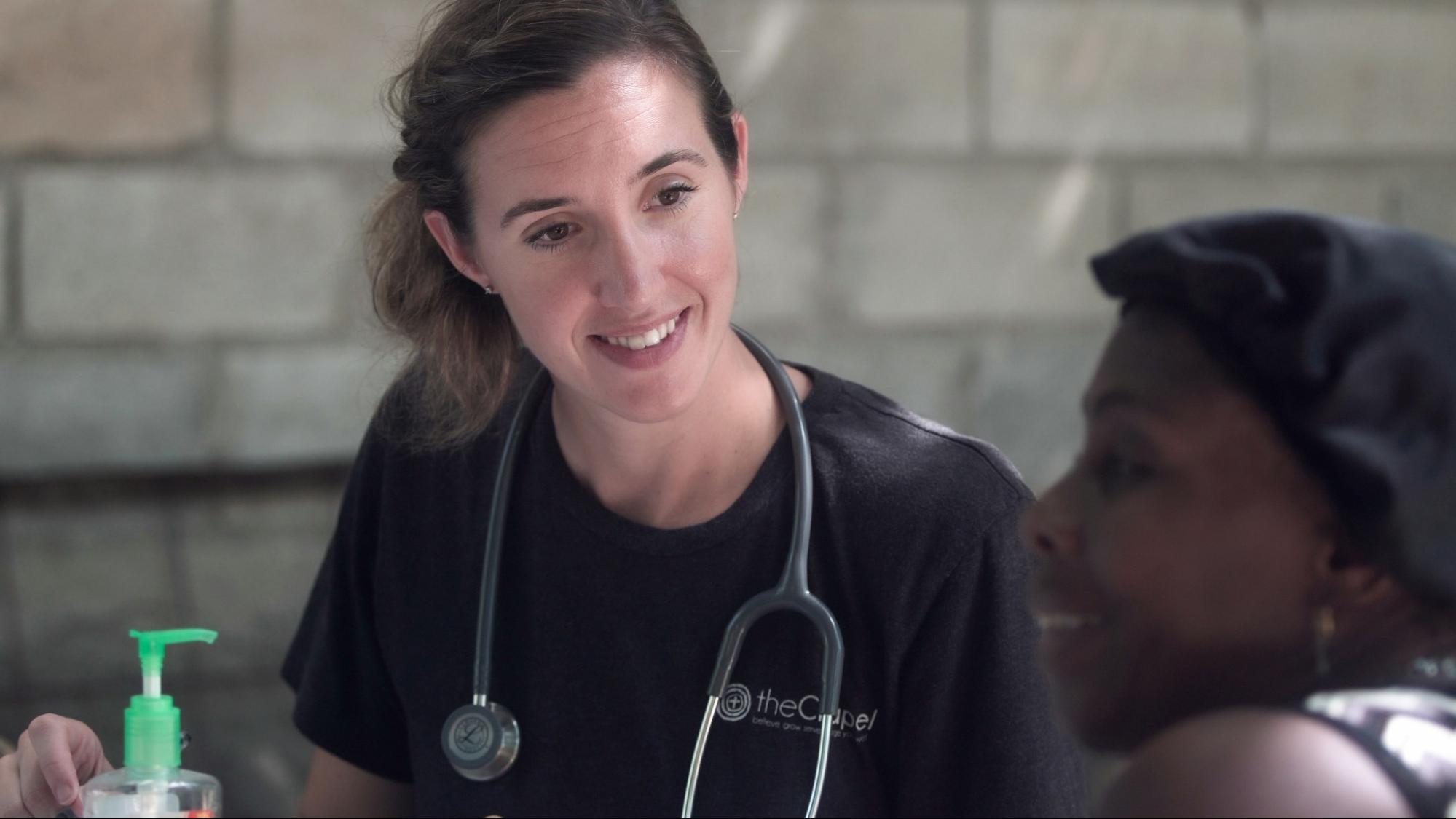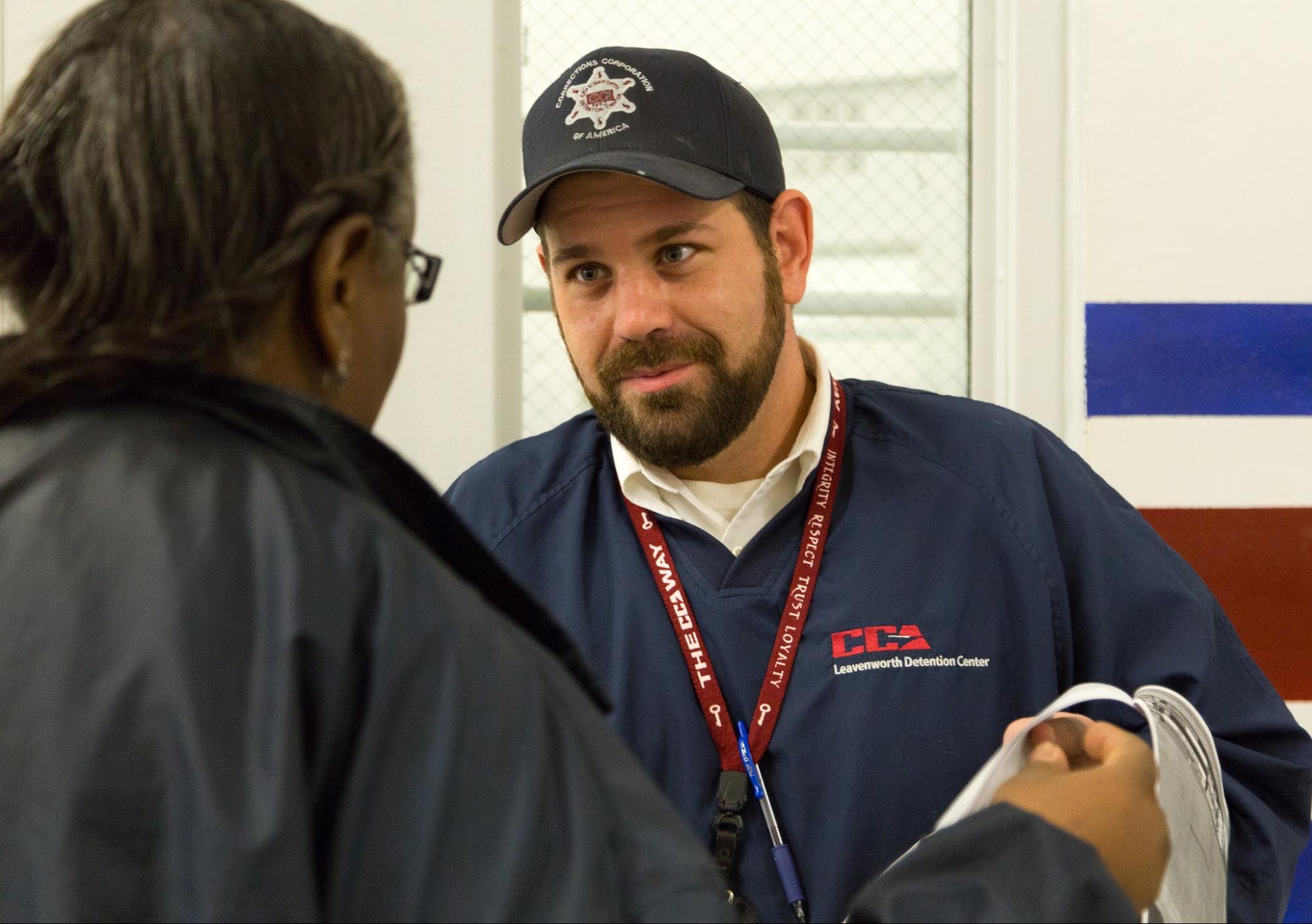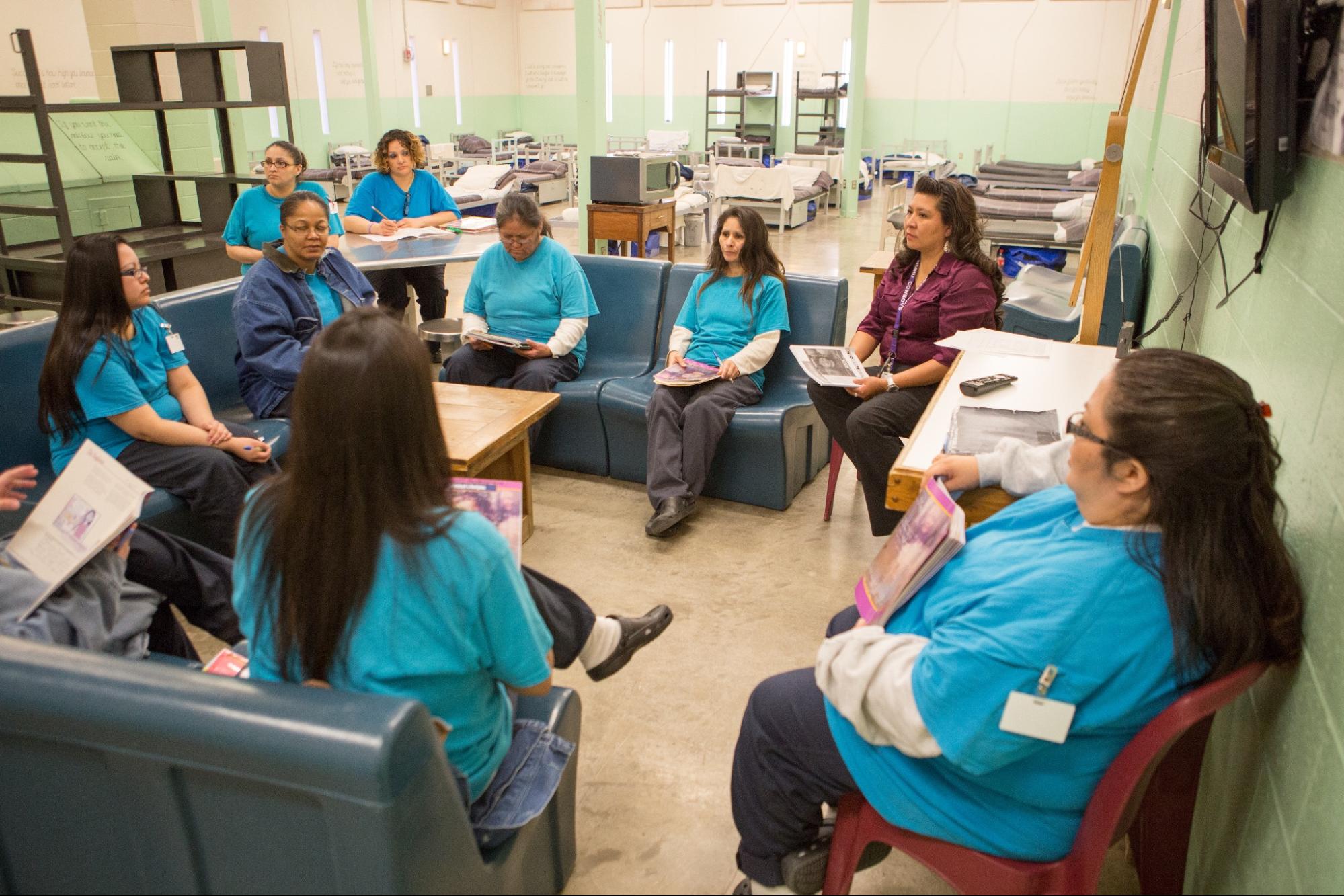7.6 Ensuring Care for People with Mental Disorders in Custody
As we have established throughout this text, many people in custody need care for mental disorders, and receiving that care is not only their right but also central to their ability to conform and succeed in custody. One of the best ways to think about caring for people in custody is to consider an objective identified throughout this text: the goal of guiding people out of more restrictive environments and into progressively less restrictive ones in ways that help them succeed (figure 7.20). Providing thoughtful and effective care for mental disorders in custody is an important aspect of this work.
Actions that support the progress of a person in custody who experiences a mental disorder can take various forms depending on the individual and their circumstances. A person may be focused on transferring from a high-security facility to a lower-security one, from restrictive behavioral health housing to the general population, or from prison to the community. Regardless of the specifics, these transitions are steps toward increasing autonomy and successfully reducing restrictions. Ensuring that incarcerated people are successful in these steps is a positive outcome for the individual as well as for the system that realizes reductions in crime and the associated costs, including imprisonment (SAMHSA, 2017). The process of transitioning to release or to a less restrictive setting should start immediately after a person enters custody.

The federal Substance Abuse and Mental Health Services Administration (SAMHSA) offers guidelines for supporting the transition of incarcerated people with mental disorders from jail or prison settings using the APIC framework, which includes the following actions:
- ASSESS: Assessing a person’s needs and safety risks
- PLAN: Planning for the treatment and services a person needs
- IDENTIFY: Identifying suitable services and programs
- COORDINATE: Coordinating a transition plan to avoid gaps in services
(SAMHSA, 2017).
Assessing Needs and Risks
Properly assessing the needs and risks of incarcerated people requires that facilities conduct universal screening as early as possible in the booking or intake process and again as necessary to ensure the detection of mental disorders (figure 7.21). Screenings do not provide diagnostic information. Rather, they are sets of standard questions intended to flag or detect individuals who are at risk for a targeted problem, such as a mental disorder. Jurisdictions vary in how they perform screenings, depending on what resources and treatment options they have.
For example, at the Gwinnett County jail in Georgia, the jail staff screens every person for veteran status and for mental illness. At the same time, staff identify each person’s needs (e.g., housing, treatment, employment, and education) and required safety precautions. Similarly, the Hancock County Justice Center in Ohio universally administers a screening instrument called the Global Appraisal of Individual Needs Short Screener (GAIN-SS), which consists of 23 questions. The screening looks for behavioral health issues as well as propensity for criminal behavior. The screening is designed to take just a few minutes to administer and can help find people who are more likely to have a mental disorder and need further assessment (Chestnut Health Systems, n.d.).

If a screened person is flagged “positive” for concerns, the facility should follow up with a more in-depth assessment that informs the facility about the services a person will need. In comparison to a screening, an assessment involves more in-depth questioning administered by a behavioral health professional. Assessments examine the nature and severity of a detected mental disorder. The assessment should also gather additional information, including demographics, the pathway to criminal involvement, strengths and protective factors, and the person’s safety risks and needs.
At the Oregon Department of Corrections, all newcomers are evaluated during a central intake process that looks for the presence of mental disorders as well as criminal risk and other needs. (Oregon Department of Corrections, n.d.-b; Oregon Department of Corrections, n.d.-a). To look for mental disorders, Oregon uses a tool called the Personality Assessment Inventory (PAI). The PAI takes around 45 minutes and requires a fourth-grade reading level to complete, so some people do need alternative means of screening (Psychological Assessment Resources, n.d.; Oregon Department of Corrections, n.d.-a). Incarcerated people with elevated PAI scores or who are identified as having recent mental health problems, who are taking psychiatric medications, or who are engaging in suicidal behaviors will receive additional evaluations, including one-on-one interviews, to determine the next steps. According to the Oregon DOC, about 60% of incarcerated people qualify for one-on-one interviews to assess mental disorders (Oregon Department of Corrections, n.d.-a).
Planning Treatment and Services
The second step under the APIC framework is planning: using information from assessments to plan care for people in custody. A key aspect of planning is collaboration between behavioral health and criminal justice professionals to determine what level of supervision and treatment an incarcerated person needs. The planning stage also includes taking immediate steps to stabilize people so that they can engage in treatment and avoid reoffending.
As with screenings and assessments, jurisdictions can approach planning in different ways. For example, some facilities hire mental health staff, while others work with outside agencies to help them develop and provide treatment for people in custody. Increased use of telehealth, which can include phone or video appointments as well as electronic exchange of medical records, increases access to mental health professionals in prisons and jails. Video calls are a cost- and time-effective way to make sure corrections staff are properly advised on how to help people be more successful in custody (figure 7.22) (Police Executive Research Forum, 2018).

Planning may anticipate that treatment and services will be delivered in the general population or in specialized housing units. Plans may include treatment with different focuses, such as managing medication, providing education, or supporting employment. Some facilities direct people into programs with phases that allow a person to graduate from one phase to another, gaining access to additional privileges and lower levels of supervision. Planning will look very different for a person expected to spend 72 hours in jail than it will for a person anticipating a longer prison stay.
Regardless of specifics, the priority is that jails and prisons engage in planning and that those plans include proven-effective treatments that will help reduce a person’s likelihood of reoffending. As we saw in our introductory example of Sedlis Dowdy, reoffending can and does occur within the correctional setting. Criminal reoffense, or simply problem behaviors in custody, are detrimental and can result in longer and more restrictive stays in custody (figure 7.23). Proper planning, based on proper assessment, helps ensure that a person in custody has the treatment and tools to succeed.

Identifying Programs
The third step of the APIC framework is the identification of specific programs that fulfill the plans for the incarcerated person that were developed based on assessments. Programs can be identified within a facility or elsewhere for people who are moving on to other facilities (e.g., transferring from jail to prison). For people who are leaving custody, especially those with mental disorders who are being released from short stays in jail, identification of and direct connection with supportive programming are critical.
Lack of access to medication, housing, or food can force a person into a revolving cycle of jail admissions and releases. In contrast, identifying a program where a person can get their needs met can disrupt that cycle, which has an enormous benefit to individuals and the system. Ideally, a facility will directly connect the person with identified resources and provide a supported transition to the next service provider. This type of transition can be accomplished via a meeting, which can be virtual, or by providing the person with transportation to the new resource if it is in the community (SAMHSA, 2022b). More specifics on the transfer of care to the community and services that should be provided there post-incarceration are discussed in Chapter 8 of this text.
Coordinating Transition Plans
Facilities recognize that no long-term treatment progress can be made if, as soon as a person moves or is transferred, their services end or drastically change. The APIC framework thus concludes with the coordination of transition plans. Coordination includes sharing information (from earlier assessments or treatment) within the criminal justice system—between facilities or with community supervision staff. When information is shared, diagnoses and medication do not need to be reestablished, needs can be met more quickly, and people in custody are relieved of some self-advocacy needs.
Coordination also includes training and education. These elements promote collaboration between criminal justice professionals and treatment or mental health professionals. Correctional personnel can be more effective and empathetic when they understand how mental disorders present (Police Executive Research Forum, 2018). Likewise, behavioral health experts benefit from a better understanding of correctional issues and public safety concerns. For both sets of professionals, understanding more about what the other does can reduce the mistrust and tension that interfere with the teamwork needed to produce effective outcomes (figure 7.24).

A variety of training approaches can be effective aspects of coordination. Crisis Intervention Team (CIT) training, discussed in Chapter 5, can be used in the corrections environment to support officers working in tandem with mental health professionals to help people with mental disorders. If you are interested in learning more about CIT training in the corrections environment, watch Crisis Intervention Training for Corrections Officers [Streaming Video], which describes this training approach and its outcomes. Trauma-informed training for corrections officers can also improve interactions between prison staff and incarcerated people, making the prison environment safer for everyone.
Trauma-informed, whether referring to care, training, or any approach to a problem, recognizes the impacts of trauma and how it may present in individuals. An officer’s approach is adjusted so that trauma is addressed and the person involved is less likely to be re-traumatized in their interaction with the officer. Actions taken with a trauma-informed approach can include simple changes like carefully explaining what a pat-down will entail before it happens, reducing the anxiety of a person who may be expecting abuse (Stringer, 2019). Trauma-informed care as a critical element of community care after release is discussed more in Chapter 8 of this text. For an excellent resource and accessible information on trauma, consider exploring the website for Trauma Informed Oregon.
One specific and interesting example of instituting trauma-informed care in a prison setting is in Hawaii’s Women’s Community Correctional Center (WCCC). In contrast to a traditional correctional setting, but consistent with Native Hawaiian cultural practices, the WCCC approach was guided by a belief in the transformative nature of a pu’uhonua, a Hawaiian term that means a protected site for healing. The WCCC initiative recognizes the significant role of trauma in most women’s paths into the criminal justice system, which are often linked to childhood abuse. It also acknowledges the particular ways in which Native Hawaiian women who are incarcerated are impacted by trauma. Many women in prison are separated from their children, a circumstance that is devastating generally but has unique consequences for women in a culture that highly values family places and connections. This is in addition to historical trauma impacting Native Hawaiian women who are part of a severely oppressed larger group (Patterson et al., 2013). Hawaii’s approach includes several days of intensive trauma-informed training for staff, treatment and service practitioners, and incarcerated individuals. The training includes identifying systemic sources of trauma; recognizing the psychological, physiological, neurobiological, and social effects of trauma; and avoiding further trauma caused by practices such as seclusion and restraint. For correctional staff, the training provides knowledge and develops skills to help them reduce the trauma and trauma-related problems of incarcerated people. For incarcerated women, the creation of the pu’uhonua reinforces trauma-informed principles by promoting empowerment and personal recovery and strengthening family and community relationships (figure 7.25).

Importantly, the coordination aspect of APIC also includes supporting people in adhering to appropriate treatment and supervision. Generally, support for adherence involves supervision with incentives that encourage compliance and sanctions that promote safety. For example, in the Massachusetts state prison system, incarcerated people who are close to release are transferred to a lower security facility. They are assigned to staff who review service plans and help schedule appointments with parole officers or treatment providers. Completing the review is a condition of discharge, providing an incentive to be sure it happens. These same staff then continue to be available to people who have been discharged from custody and can be consulted for mentoring, crisis intervention, or referrals. Especially high-risk people (e.g., very violent records, gun charges) are linked with specially trained staff who stay even more closely involved by transporting clients to treatment appointments and supervision meetings. These connections are examples of coordination that keeps people on track.
Licenses and Attributions for Ensuring Care for People with Mental Disorders in Custody
Open Content, Shared Previously
“Ensuring Care for People with Mental Disorders in Custody” by Anne Nichol is adapted from “Guidelines for Successful Transition of People with Mental or Substance Use Disorders from Jail and Prison: Implementation Guide” by SAMHSA, which is in the Public Domain. Modifications, licensed CC BY-NC 4.0, include substantial revisions and condensing and expanding the content.
Figure 7.20. Photo by Afif Ramdhasuma is licensed under the Unsplash License.
Figure 7.21. Photo by TopSphere Media is licensed under the Unsplash License.
Figure 7.22. Photo by National Cancer Institute is licensed under the Unsplash License.
Figure 7.23. Photo by Quỳnh Lê Mạnh is licensed under the Unsplash License.
Figure 7.24. Correctional Officer by CoreCivic is licensed under CC BY-ND 2.0.
Figure 7.25. Female Inmates in a RDAP Program by CoreCivic is licensed under CC BY-ND 2.0.

